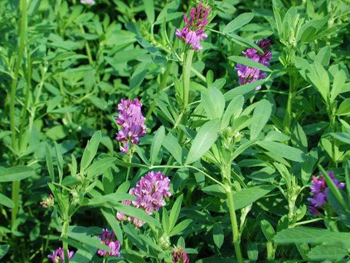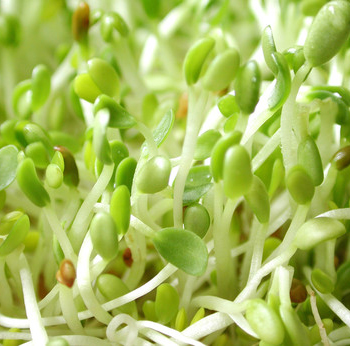Contents:
Common Names | Parts Usually Used | Plant(s) & Culture | Where Found | Medicinal Properties | Biochemical Information
Legends, Myths and Stories | Uses | Formulas or Dosages | Nutrient Content | How Sold | Warning | Resource Links | Bibliography
Scientific Names

Alfalfa |
- Medicago sativa L.
- Leguminosae
- Pea family
Common Names
- Buffalo herb
- Lucerne
- Mu-su
- Purple medic
Parts Usually Used
Flowering plant, leaves petals, flowers and sprouts.
Back to Top
Description of Plant(s) and Culture
 Alfalfa Sprouts |
A deep-rooted perennial plant (Medicago sativa) of the pea family with small divided leaves, purple cloverlike flowers (violet-blue) in loose heads,
Back to Top
Where Found
Fields, roadsides. Throughout the United States. Often cultivated as a crop. Native to Asia.
Back to Top
Medicinal Properties
Alterative, antipyretic, diuretic, appetite stimulant, hemostatic
Back to Top
Biochemical Information
Contains organic minerals such as calcium, magnesium, phosphorus, and potassium and almost all known vitamins, as well as very high in chlorophyll
Back to Top
Legends, Myths and Stories
First discovered by the Arabs, who dubbed alfalfa, this valuable plant, as the “father of all foods.”
According to an early Oriental herbarium, alfalfa tops the list of 896 plants cited, and originated in Persia.
Alfalfa (M. sativa), a native of Asia, didn’t reach North America until around 1850 or 1860. Native Americans adapted alfalfa quickly for human use, as well as for animals. In England and South Africa it is called Buffalo herb.
Called Mu-su, this is one of the plants said to have been brought to China by General Chang Chien of the Han dynasty. The mu-su is included among the vegetables, and was formerly extensively cultivated; and in some parts of China, is still grown. It is found growing almost of its own accord.
The first documented use of this herb by the Chinese dates back to the 6th century. Chinese healers use alfalfa to treat kidney stones and to relieve fluid retention and swelling. Chinese name: Muxu or zimu
The Sting Plant (Psoralea lanceolata) known as White alfalfa (Native American name “Pooy sonib”) has fibrous roots that can be split exceptionally fine for string, nets, etc. Fragrant, and will not rot in water.
Back to Top
Uses
Alfalfa tea is commonly used as a beverage; it is also used medicinally.
Nutritious fresh or dried leaf tea traditionally used to promote appetite, weight gain, diuretic, stops bleeding.
A source of commercial chlorophyll and carotene, both with valid health claims. Contains the anti-oxidant tricin.
Experimentally, antifungal, and setrogenic. Unsubstantiated claims include use for cancer, diabetes, alcoholism, arthritis, etc.
High in chlorophyll and nutrients. Alkalies the body and detoxifies the body, especially the liver. Good for all colon disorders, anemia, hemorrhaging, indigestion, vitamin or mineral deficiency, laxative, cystitis, blood purifier, gas, edema, diabetes, ulcers, and arthritis. Promotes pituitary gland function. Contains an antifungus agent.
Back to Top
Formulas or Dosages
Infusion: mix
Fresh: toss alfalfa sprouts in a salad.
For relief of rheumatoid arthritis, take
Back to Top
Nutrient Content
Biotin, calcium, choline, inositol, iron, magnesium, PABA, phosphorus, potassium, protein, sodium, sulfur, tryptophan (amino acid), and vitamins A, B complex, C, D, E, K, P, and U.
Back to Top
How Sold
Capsules: take 3 to 6 daily.
Back to Top
Warning
Alfalfa has been known to aggravate lupus and other auto-immune disorders. Avoid alfalfa is you have an auto-immune problem.
Consuming large quantities of Alfalfa saponins may cause breakdown of red blood cells, causing bloating in livestock (thus weight gain). Recent reports suggest that Alfalfa sprouts (or the canavanine therein, especially in the seeds), may be associated with lupus (systemic lupus erythematosus), causing recurrence in patients in which the disease had become dormant.
Back to Top
Resource Links
LiveStrong.com: What Are the Benefits of Kelp Alfalfa?
LiveStrong.com: What Are the Benefits of Alfalfa Grass?
Memorial Sloan-Kettering Cancer Center: Alfalfa
U.S. National Library of Medicne: Alfalfa
Bibliography
![]() The Herb Book
The Herb Book, by John Lust, Bantam Books, 666 Fifth Avenue, New York, NY. copyright 1974.
![]() Chinese Medicinal Herbs
Chinese Medicinal Herbs, compiled by Shih-Chen Li, Georgetown Press, San Francisco, California, 1973.
![]() Indian Herbalogy of North America
Indian Herbalogy of North America, by Alma R. Hutchens, Shambala Publications, Inc., Horticultural Hall, 300 Massachusetts Avenue, Boston, Massachusetts 02115, 1973
![]() Eastern/Central Medicinal Plants
Eastern/Central Medicinal Plants, by Steven Foster and James A. Duke., Houghton Mifflin Company, 215 Park Avenue South, New York, NY 10000
 Earl Mindell’s Herb Bible
Earl Mindell’s Herb Bible, by Earl Mindell, R.Ph., Ph.D., Simon & Schuster/Fireside, Rockefeller Center 1230 Avenue of the Americas, New York, New York 10020
![]() The Nature Doctor: A Manual of Traditional and Complementary Medicine
The Nature Doctor: A Manual of Traditional and Complementary Medicine, by Dr. H.C.A. Vogel; Keats Publishing, Inc., 27 Pine Street (Box 876) New Canaan, CT. 06840-0876. Copyright Verlag A. Vogel, Teufen (AR) Switzerland 1952, 1991
 Secrets of the Chinese Herbalists
Secrets of the Chinese Herbalists, by Richard Lucas, Parker Publishing Company, Inc., West Nyack, NY, 1987.
![]() Indian Uses of Native Plants
Indian Uses of Native Plants, by Edith Van Allen Murphey, Meyerbooks, publisher, PO Box 427, Glenwood, Illinois 60425, copyright 1958, print 1990
![]() Prescription for Nutritional Healing, Fifth Edition: A Practical A-to-Z Reference to Drug-Free Remedies Using Vitamins, Minerals, Herbs & Food Supplements
Prescription for Nutritional Healing, Fifth Edition: A Practical A-to-Z Reference to Drug-Free Remedies Using Vitamins, Minerals, Herbs & Food Supplements, by James F. Balch, M.D. and Phyllis A. Balch, C.N.C., Avery Publishing Group, Inc., Garden City Park, NY
![]() Webster’s New World Dictionary
Webster’s New World Dictionary, Third College Edition, Victoria Neufeldt, Editor in Chief, New World Dictionaries: A Division of Simon & Schuster, Inc., 15 Columbus Circle, New York, NY 10023
![]() The Yoga of Herbs: An Ayurvedic Guide to Herbal Medicine
The Yoga of Herbs: An Ayurvedic Guide to Herbal Medicine, by Dr. David Frawley & Dr. Vasant Lad, Lotus Press, Twin Lakes, Wisconsin, Second edition, 1988.
